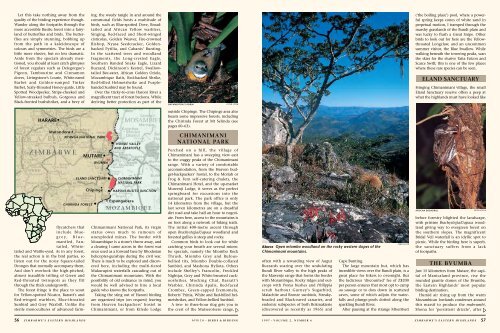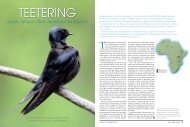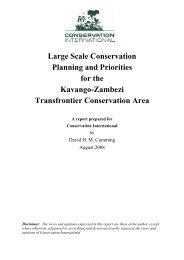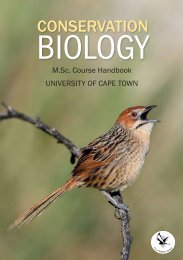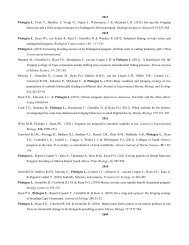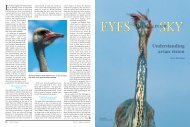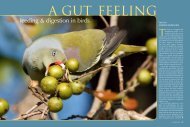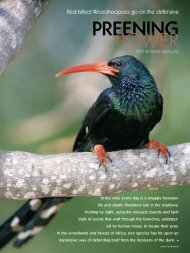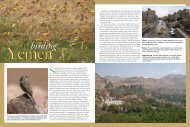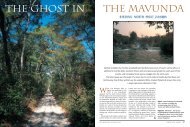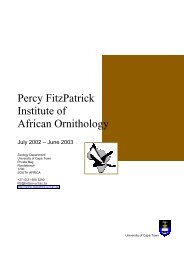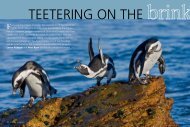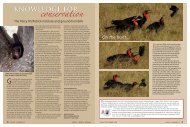Highland low-down: birding Zimbabwe's Eastern Highlands
Highland low-down: birding Zimbabwe's Eastern Highlands
Highland low-down: birding Zimbabwe's Eastern Highlands
Create successful ePaper yourself
Turn your PDF publications into a flip-book with our unique Google optimized e-Paper software.
Let this take nothing away from the<br />
quality of the <strong>birding</strong> experience though.<br />
Wander along the footpaths through the<br />
more accessible Rusitu forest into a fairyland<br />
of butterflies and birds. The butterflies<br />
are simply stunning, bobbing up<br />
from the path in a kaleidoscope of<br />
colours and symmetries. The birds are a<br />
little more elusive, but no less dramatic.<br />
Aside from the specials already mentioned,<br />
you should at least catch glimpses<br />
of forest regulars such as Delegorgue’s<br />
Pigeon, Tambourine and Cinnamon<br />
doves, Livingstone’s Lourie, White-eared<br />
Barbet and Golden-rumped Tinker<br />
Barbet, Scaly-throated Honey-guide, Little<br />
Spotted Woodpecker, Stripe-cheeked and<br />
Yel<strong>low</strong>-streaked bulbuls, Gorgeous and<br />
Black-fronted bushshrikes, and a bevy of<br />
HARARE•<br />
Marondera •<br />
ZimBaBWe<br />
nyanga national park<br />
flycatchers that<br />
include Bluegrey,Bluemantled,Fantailed,Whitetailed<br />
and Wattle-eyed. As in any forest,<br />
the real action is in the bird parties, so<br />
listen out for the noisy Square-tailed<br />
Drongos that normally accompany them.<br />
And don’t overlook the high-pitched,<br />
almost inaudible trilling of Green and<br />
Red-throated twinspots as they flit<br />
through the thick undergrowth.<br />
The forest fringe is the place to scout<br />
for Yel<strong>low</strong>-spotted Nicator, Barratt’s and<br />
Red-winged warblers, Blue-throated<br />
Sunbird and Grey Waxbill. Unlike the<br />
sterile monocultures of advanced farm-<br />
ing, the weedy tangle in and around the<br />
communal fields hosts a multitude of<br />
birds, such as Blue-spotted Dove, Broadtailed<br />
and African Yel<strong>low</strong> warblers,<br />
Singing, Red-faced and Short-winged<br />
cisticolas, Golden Weaver, Fire-crowned<br />
Bishop, Nyasa Seedcracker, Goldenbacked<br />
Pytilia, and Cabanis’ Bunting.<br />
In the scattered trees and woodland<br />
fragments, the Long-crested Eagle,<br />
Southern Banded Snake Eagle, Lizard<br />
Buzzard, Dickinson’s Kestrel, Swal<strong>low</strong>tailed<br />
Bee-eater, African Golden Oriole,<br />
Mozambique Batis, Red-backed Shrike,<br />
Red-billed Helmetshrike and Purplebanded<br />
Sunbird may be found.<br />
Over the tricky-to-cross Haroni River a<br />
magnificent tract of forest beckons. While<br />
deriving better protection as part of the<br />
MUTARE•<br />
bvumba<br />
eland sanCtuary •<br />
•<br />
Chipinge<br />
CHirinda forest •<br />
•<br />
• Honde valley<br />
and aberfoyle<br />
CHimanimani<br />
nationl park<br />
Haroni-rusitu JunCtion<br />
• Espungabera<br />
moZamBiQue<br />
Chimanimani National Park, its virgin<br />
status owes much to rumours of<br />
unexploded mines. The border with<br />
Mozambique is a stone’s throw away, and<br />
a clearing I came across in the forest was<br />
once used as a forward base by Rhodesian<br />
helicopter-gunships during the civil war.<br />
There is much to be explored and discovered<br />
here, including the multi-tiered<br />
Mukurupini waterfalls cascading out of<br />
the Chimanimani mountains. With the<br />
possibility of old ordnance in mind, you<br />
would be well advised to hire a local<br />
guide who knows the footpaths.<br />
Taking the sting out of Haroni <strong>birding</strong><br />
are organized trips (on request) leaving<br />
from Heaven backpackers’ hostel in<br />
Chimanimani, or from Kiledo Lodge<br />
swynnerton’s robin<br />
outside Chipinge. The Chipinge area also<br />
boasts some impressive forests, including<br />
the Chirinda Forest at Mt Selinda (see<br />
pages 60–63).<br />
chimanimani<br />
national Park<br />
peter steyn<br />
Perched on a hill, the village of<br />
Chimanimani has a sweeping view east<br />
to the craggy peaks of the Chimanimani<br />
range. With a variety of comfortable<br />
accommodation, from the Heaven budget-backpackers’<br />
hostel, to the Moriah or<br />
Frog & Fern self-catering chalets, the<br />
Chimanimani Hotel, and the up-market<br />
Muwenji Lodge, it serves as the perfect<br />
springboard for excursions into the<br />
national park. The park office is only<br />
14 kilometres from the village, but the<br />
last seven kilometres are on a dreadful<br />
dirt road and take half an hour to negotiate.<br />
From here, access to the mountains is<br />
on foot along a network of hiking trails.<br />
The initial 400-metre ascent through<br />
open Brachystegia/Uapaca woodland and<br />
forested gullies is steep and rocky.<br />
Common birds to look out for while<br />
catching your breath are several miombo<br />
specials, namely the Miombo Rock<br />
Thrush, Miombo Grey and Rufous-<br />
bellied tits, Miombo Double-collared<br />
Sunbird, and Mashona Hyliota. Others<br />
include Shelley’s Francolin, Freckled<br />
Nightjar, Grey and White-breasted cuckooshrikes,<br />
Mocking Chat, Barratt’s<br />
Warbler, Chirinda Apalis, Red-faced<br />
Crombec, Green-capped Eremomela,<br />
Roberts’ Prinia, White and Red-billed helmetshrikes,<br />
and Yel<strong>low</strong>-bellied Sunbird.<br />
A two- to three-hour slog gets you to<br />
the crest of the Mutserotsero range, <br />
56 ZIMBABWE’S EASTERN HIGHLANDS<br />
africa – Birds & Birding<br />
Above open miombo woodland on the rocky western slopes of the<br />
Chimanimani mountains.<br />
often with a rewarding view of Augur<br />
Buzzards soaring over the undulating<br />
Bundi River valley to the high peaks of<br />
the Mawenje range that forms the border<br />
with Mozambique. Rocky ridges and outcrops<br />
with Protea bushes and Philippia<br />
scrub harbour Gurney’s Sugarbird,<br />
Malachite and Bronze sunbirds, Streakyheaded<br />
and Black-eared canaries, and<br />
endemic subspecies of both Bokmakierie<br />
(discovered as recently as 1965) and<br />
1997 – volume 2, numBer 6<br />
Cape Bunting.<br />
The large mountain hut, which has<br />
incredible views over the Bundi plain, is a<br />
great place for hikers to overnight. But<br />
the ludicrous ‘discounted’ fee of Z$200<br />
per person ensures that most opt to camp<br />
au sauvage or to doss <strong>down</strong> in scattered<br />
caves, some of which adjoin the waterfalls<br />
and plunge-pools dotted along the<br />
sparkling Bundi River.<br />
After pausing at the strange Mtseritseri<br />
or<br />
penn lloyd<br />
(‘the boiling place’) pool, where a powerful<br />
spring keeps cones of white sand in<br />
perpetual motion, I tramped through the<br />
marshy grasslands of the Bundi plain and<br />
was lucky to flush a Great Snipe. Other<br />
birds to look out for here are the Yel<strong>low</strong>throated<br />
Longclaw, and an uncommon<br />
summer visitor, the Blue Swal<strong>low</strong>. While<br />
walking beneath the towering peaks, scan<br />
the skies for the elusive Taita Falcon and<br />
Scarce Swift; this is one of the few places<br />
where these rare species can be seen.<br />
eland sanctuary<br />
Fringing Chimanimani village, the small<br />
Eland Sanctuary reserve offers a peep at<br />
what the highlands must have looked like<br />
afriCan broadbill<br />
before forestry blighted the landscape,<br />
with pristine Brachystegia/Uapaca woodland<br />
giving way to evergreen forest on<br />
the southern slopes. The magnificent<br />
Bridal Veil waterfall is an idyllic spot to<br />
picnic. While the <strong>birding</strong> here is superb,<br />
the sanctuary suffers from a lack<br />
of footpaths.<br />
the BvumBa<br />
Just 15 kilometres from Mutare, the capital<br />
of Manicaland province, rise the<br />
rounded granite domes of the Bvumba,<br />
the <strong>Eastern</strong> <strong>Highland</strong>s’ most popular<br />
<strong>birding</strong> destination.<br />
Humid air rising up from the warm<br />
Mozambican <strong>low</strong>lands condenses around<br />
this massif to produce the mubvumbi,<br />
Shona for ‘persistent drizzle’, after <br />
ZIMBABWE’S EASTERN HIGHLANDS<br />
peter steyn<br />
57


